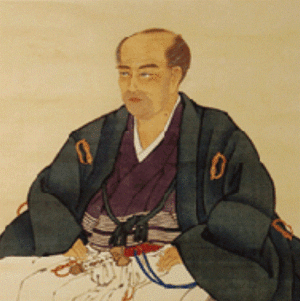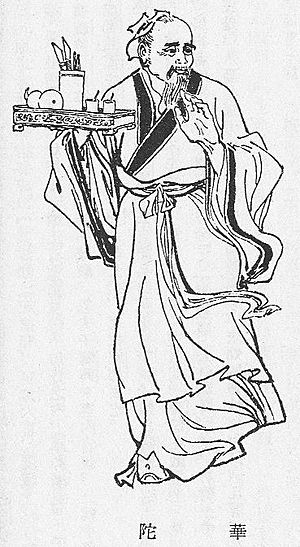Hanaoka Seishū facts for kids
Quick facts for kids
Hanaoka Seishū
|
|
|---|---|

Hanaoka Seishū
|
|
| Born | October 23, 1760 |
| Died | November 21, 1835 (aged 75) Japan
|
| Nationality | Japanese |
| Citizenship | Japan |
| Alma mater | Kyoto, Japan |
| Known for | first to perform surgery using general anesthesia |
| Scientific career | |
| Fields | Medicine, surgery |
| Institutions | Japan |
| Academic advisors | Nangai Yoshimasu (1750-1813) |
| Influences | Yoshio Kōsaku (1724-1800)
Kenryu Yamato (1740-1780) Hanaoka Jikido |
| Influenced | Shutei Nakagawa (1773–1850)
Gendai Kamada (1794–1855) Gencho Homma (1804-1872) |
Hanaoka Seishū (華岡 青洲, October 23, 1760 – November 21, 1835) was a famous Japanese surgeon. He lived during the Edo period in Japan. Hanaoka knew a lot about Chinese herbal medicine. He also learned Western surgical methods through something called Rangaku. This means "Dutch learning" or "Western learning." Many people say Hanaoka was the first person to perform surgery using general anesthesia. This means making a patient completely unconscious during an operation.
Contents
How Hanaoka Seishū Became a Surgeon
Hanaoka Seishū studied medicine in Kyoto, a big city in Japan. After his studies, he became a doctor in Wakayama prefecture. This area was near Osaka, where he was born. Hanaoka learned both traditional Japanese medicine and European surgery. He learned the European methods through "Dutch learning."
At that time, Japan had a strict policy called Sakoku. This policy meant Japan was mostly closed off from the rest of the world. Very few foreign medical books were allowed into the country. This made it hard for Hanaoka and other Japanese doctors to learn about new medical discoveries from the West.
Hanaoka became one of the most important Japanese surgeons of his time. He was known for mixing Dutch and Japanese surgical ideas. He brought new surgical methods to Japan. Hanaoka even performed some types of plastic surgery. He was the first surgeon in the world to use general anesthesia for operations. He bravely operated on cancers of the breast and mouth. He also removed dead bone and performed amputations (removing limbs) in Japan.
Hua Tuo and Ancient Anesthesia

You might wonder where Hanaoka got his ideas. He was inspired by an ancient Chinese surgeon named Hua Tuo. Hua Tuo lived around AD 145-220. He was famous for performing surgery using general anesthesia. He used a special mixture of wine and herbal extracts. He called this mixture mafeisan.
Hua Tuo reportedly used mafeisan for big operations. These included removing parts of diseased intestines. Before surgery, he gave patients a drink. This drink likely made them unconscious and relaxed their muscles.
Sadly, the exact recipe for mafeisan was lost. Hua Tuo burned his writings before he died. Also, in ancient China, surgery was not very popular. Many people believed the body was sacred. So, surgery was seen as harming the body. Because of this, surgery largely stopped in China after Hua Tuo's death.
Many experts have tried to guess what was in mafeisan. The exact ingredients are still a mystery. Some believe it contained plants like Angelica dahurica and Datura metel. Some think Hua Tuo might have also used acupuncture for pain relief. No one has been able to perfectly recreate his formula. It also seems his formula wasn't always effective for very major operations.
Creating Tsūsensan: Hanaoka's Anesthetic

Hanaoka was very interested when he learned about Hua Tuo's mafeisan. Around 1785, Hanaoka started his own mission. He wanted to create a similar compound. This new compound would have properties like Hua Tuo's mafeisan.
His wife even helped him with his experiments. She volunteered and sadly lost her eyesight due to side effects. After many years of hard work, Hanaoka finally created his own formula. He named it tsūsensan (also called mafutsu-san). Like Hua Tuo's mixture, tsūsensan was made from extracts of several plants.
Some of the plants in tsūsensan included:
- 8 parts yang jin hua (Datura stramonium, also known as jimson weed).
- 2 parts bai zhi (Angelica dahurica).
- 2 parts cao wu (Aconitum sp., or monkshood).
- 2 parts chuān ban xia (Pinellia ternata).
- 2 parts chuān xiōng (Ligusticum wallichii).
- 2 parts dong quai (Angelica sinensis).
- 1 part tian nan xing (Arisaema rhizomatum).
The mixture was ground into a paste. Then, it was boiled in water and given to patients as a drink. After 2 to 4 hours, the patient would stop feeling pain. Then, they would become unconscious. Depending on the amount given, they could stay unconscious for 6 to 24 hours. The active ingredients in tsūsensan caused general anesthesia. They also made the body's muscles relax.
First Surgery with Tsūsensan
Once Hanaoka perfected his sedative drink, he started using it. He used it to make his patients unconscious for surgery. This was similar to how modern general anesthesia works.
On October 13, 1804, Hanaoka performed a surgery on a 60-year-old woman named Kan Aiya. Her family had a history of breast cancer. Hanaoka removed part of her breast cancer. He used tsūsensan as the general anesthetic. Many people today consider this the first well-documented surgery done with general anesthesia. It was almost 40 years before another doctor, Crawford Long, used general anesthesia in the United States.
News of Hanaoka's painless operations spread quickly. Patients came from all over Japan to see him. Hanaoka performed many operations using tsūsensan. These included removing cancerous tumors. He also removed bladder stones and performed limb amputations. Before he died in 1835, Hanaoka performed over 150 breast cancer operations. He also designed new surgical tools. He taught many students his unique medical ideas. His surgical methods became known as the "Hanaoka method."
Hanaoka's Lasting Impact
Hanaoka's work helped many patients. However, his discoveries did not immediately spread around the world. Japan's national isolation policy kept his achievements a secret. This policy ended in 1854. By then, other doctors in America and Europe had already developed their own ways to use general anesthesia.
Still, Hanaoka's work is honored in Japan. The Japan Society of Anesthesiologists uses a picture of the Korean morning glory flower in their logo. This is to remember Hanaoka's important pioneering work.
Hanaoka's old house is still preserved in his hometown. It is in Naga-cho, which is now part of Kinokawa, Wakayama. The house has exhibits in both Japanese and English. It is next to a nursing college. Many local doctors and nurses visit to honor Hanaoka and his work.
Hanaoka in Popular Culture
The Japanese author Sawako Ariyoshi wrote a novel about Hanaoka Seishū. It is called The Doctor's Wife (in Japanese, 華岡青洲の妻). This book mixes facts from Hanaoka's life with a fictional story. The story focuses on a conflict between his mother and his wife. This novel was later made into a 1967 movie. The movie was directed by Yasuzo Masumura. It was called Hanaoka Seishū no tsuma (also known as "The Wife of Seishu Hanaoka").
See also
 In Spanish: Hanaoka Seishū para niños
In Spanish: Hanaoka Seishū para niños
- History of general anesthesia
- Takamine Tokumei

